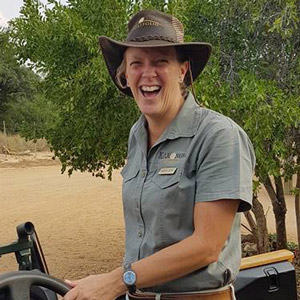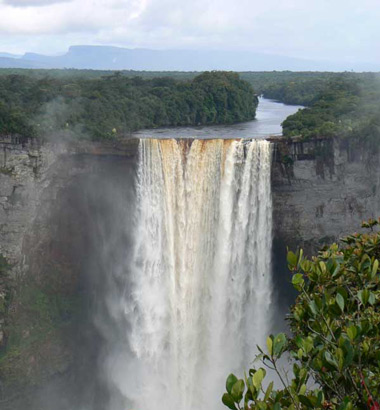
I recently spent ten days exploring some of Guyana's natural highlights, and can concur that it is the untouched and pristine nature of the country that makes it so unique. It was a privilege to visit.
After an uneventful flight to Georgetown, I arrived into a lovely and warm Guyana. After a good night’s rest at a hotel in the city, we were whisked off to the Botanical Gardens. It was a lovely cool morning that promised a hot, clear day later. As soon as we got out of the vehicle, our guide Carlos was on fire. With his scope and bird book never far away, we were soon clocking up species like there was no tomorrow. Blood coloured woodpecker, great horned owl (superb sighting!), tropical kingbird, greater and little keskadee, festive parrots, pearl kite, snail kite, grey hawk, red shouldered macaw, laughing falcon, squirrel cuckoo, white bellied piculet, tropical mockingbird, blue grey tanager, yellow oriole and the list goes on. Carlos mentioned that it is possible to record on average 50 species during a short visit.


Next on our itinerary was a flight down to the South Rupununi region, then a drive to Caiman House Lodge. There were plenty of birds around and we saw our first jabirus, and we ticked off heaps of species visible from the road such as white-headed marsh tyrant, savanna hawk, turkey vulture, black vulture, whistling duck, giant heron, little blue heron and cattle egret. The Rupununi River is a short walk from the lodge and we set off late afternoon for our first motorised excursion. No otters today but instead we were spoilt with avian sightings: brown chested martins and swifts darted along beside us as muscovy duck, cocoi heron, puff birds, agama heron, black crowned night heron, anhinga (snake bird), limpkin, ani and Amazonian and ring kingfishers flew overhead. The sheer number of species that we counted was staggering.
It was an early start the next morning as we we boarded dugout canoes for a morning’s glide on an oxbow lake, before heading through a mangrove channel to the Rupununi River. Bird after bird after bird was seen and then one of the guides thought they saw an otter. Steering the dugouts with surprising dexterity, we made out way around a small island and sure enough, two heads popped up before promptly disappearing again. We were able to follow their heads as they popped up and down towards a caiman going about its business before disappearing. Wow! We’d seen them!
We enjoyed a wonderful afternoon cruising on the river again, before making our way to another oxbow lake for rum sundowners in the boats, whilst watching the colours in the sky change and fade. Moored alongside more Victoria amazonica, I was chuffed to bits to watch jacanas and my first ever pair of gallinules walking over the spongy lily pads in front of us.

Another early start the next day and we were clambering into Karanambu’s two 4x4s. We were driven a little way before the driver stopped and asked us to bring our cameras and stand in the savannah. This we duly did and then the grins started! A few hundred metres from us was a vaquero cantering through the bush and in front of him was undoubtedly a giant anteater! With its long, long hair floating in the wind it looked akin to a large dark brown flat coated retriever. It came right towards to us and then ran left and right giving us the opportunity to take some wonderful photos. The setting was perfect, the light was stunning and it will be a moment I will remember for years to come.


Leaving the savannah behind, we drove towards the Amerindian community of Surama and our overnight accommodation, Surama Eco Lodge. The landscape changed as we reached the foothills of the Pakaraima Mountains and suddenly, after passing through Annai, we were in rainforest and following the trans-national highway that leads all the way to Georgetown, eight or so hours away. With huge trees alive with bird calls towering over us on either side of the road, I felt like we had arrived! Located in a small patch of savannah completely surrounded by rainforest, accommodation at Surama is provided in four simple rondavel style circular cottages that are accessed through a hand painted door covered in either a wildlife or Amerindian scene.
We enjoyed a rainforest walk to and from the Burro Burro River, followed by a boat trip looking for wildlife. Our guide, Gary, was superb and we saw our first curassow at the start of the walk, as well as tracks for silky anteater, tapir and capybara. Listening to the wonderful call of a screaming piha (now synonymous with rainforest!), a lucky look up provided us with a beautiful violaceous trogon perched calmly above us. It proved to be obliging and posed for us beautifully. Once at the river, we boarded our boats and soon we’re seeing our first channel billed toucans, macaws and green acacaris. On the bank side bamboo we watched capuchin monkeys and on the ground, grey necked wood rail.
The following day we awoke to the sound of howler monkeys. We drove to the base of Mount Surama from where we commenced our rainforest hike. Our aim was not to reach the top but to enjoy breakfast with a view from a rocky outcrop. We walked for around an hour enjoying a myriad of bird calls along the way. We were somewhat hot and sweaty by the time we reached our destination but it was well worth it! As we took in the wonderful views, we noticed some red and green macaws flying below us over the canopy. Truly magnificent, we watched as they flew back and forth and back and forth in tandem. Definitely one of my favourite moments on the trip.


We did stop however for something quite unexpected…crabs! On a mountain? In a rainforest? Yes and yes. Not just any crabs either. These had a jaguar face on their shells, a common tactic to surprise predators with to make them think they are dealing with a larger creature than they actually are (think eyes on the back of a rearing cobra’s head or eyes on moth wings).
We pressed on to our next destination, Iwokrama River Lodge with a stop en route at an infamous cock of the rock lekking site. Scouring the trees around us for a flash of orange proved unsuccessful so we followed Carlos on to the next lot of rocks up a small incline and voila! We couldn’t believe it as a glorious male sat around 20 metres away from us seemingly oblivious to our presence.
Up at the crack of dawn the next day we boarded the boats for a short dawn cruise that proved to be atmospheric as the mist slowly rose from the water. We were also lucky enough to glide directly underneath our second violaceous trogon of the trip. We headed back down the trans-national highway to Atta Rainforest Lodge, a lovely little lodge set in a clearing, completely and utterly surrounded by rainforest. The beauty of the lodge’s location soon became apparent with fruit crows spotted, followed by black vultures on the lawn and a number of red howler monkeys that came to check us out from the safety of their lofty perches above us. We took off to explore the canopy walkway and walked one by one along the hanging bridges suspended 30 metres above ground. The forest was quiet and peaceful in the late afternoon sun. Once back at the lodge we again jumped into the vehicles, eager to try our luck with another night drive. No jaguars but we did see two kinkajous - a nocturnal creature similar to an African bush baby.


The next morning I was awake with the howlers (wonderful!) at 0440 and a guided walk. We were looking particularly for a hummer, the crimson topaz. As we hit the main road the misty morning gave way to a riot of colour and we enjoyed red and green macaws, painted parakeet, cream coloured woodpecker and a pygmy kingfisher as well as our jackpot! Our journey then was back towards Annai, before travelling by boat onto Rewa Eco Lodge. As we drove along, our guide suggested that he’d seen something. Sure enough, there, in all its glory, was a harpy eagle on the tallest dead branch around giving us a clear and uninterrupted view. After 15 minutes or so it flew to another tree further down the road (anything to avoid the screeching warnings of the macaws panicking nearby) and we walked along with it and maintained our incredible view. Another 20 minutes or so later and the same happened again. iPhone photos taken through the scope were proving to be winners and our guide declared it in his top three harpy sightings ever. With red howler monkeys, spectacled caiman and squirrel monkeys seen along the way, we sat back and soaked up the scenery, arriving at Rewa at dusk.
The following day we travelled upriver by boat and then commenced a one hour walk through the rainforest in search of bird eating spiders. We stopped by some huge tree buttresses and saw jaguar claw marks on one tree. Examining them more closely, we were just about able to discern the scent of its urine before continuing with our quest. We were successful and our guide enticed a large tarantula out of its subterranean burrow for photos. The walk back took slightly less than an hour and we headed back towards the lodge stopping by a sandbank that was filled to the brim with black skimmers, pied lapwing and yellow billed terns. We watched transfixed as they flew around us before stopping again a little later for blue and yellow macaws, red howler monkeys and golden handed tamarin.


Our final part of the journey was a flight to Kaieteur Falls. We clambered onboard the plane and 30 minutes later the skies had cleared giving us superb views of the rainforest clad interior and mesa mountain tops as we approached the falls. WOW! There it was! Grinning from ear to ear, we couldn’t believe it. Our guide saw a cock of the rock along our path but by the time we got to him, it had flown away. Finally we made it to Johnson’s View and quite frankly, we were blown away. Rain was in the air but we managed a few shots before thick cloud and mist rolled in. We walked closer to the falls themselves taking in Rainbow View and Boy Scout’s View. White collared swifts were swirling above us preparing to dart underneath the curtain of water where they roost for the night behind the falls. There were simply no words…
This had been an absolutely superb trip. Guyana surprised me in many ways. I was expecting virgin rainforest to cover the entire country but loved the fact that savannah holds so many treasures in terms of added biodiversity and wonderfully open landscapes. The sheer number of bird species that we were party to, without even particularly trying, was staggering, and the welcome we received at lodges across the country was brilliant.
Join us in Guyana on a wildlife bonanza - you won’t be disappointed!
Call Helen to reserve your place.

